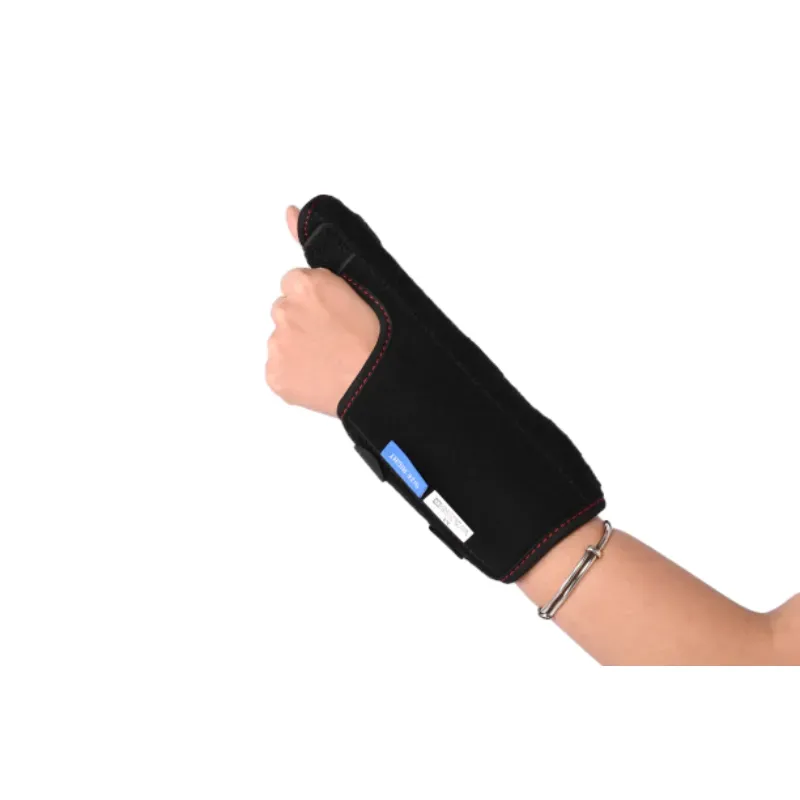探索腕夹板设计的生物力学
腕部夹板的生物力学在以下产品的设计和有效性中起着至关重要的作用: 腕部夹板出售, 带腕部支撑的手指夹板, 和 柔性拇指夹板. Understanding the natural movements and forces acting on the wrist is essential in creating splints that offer proper support, flexibility, and comfort. In this article, we’ll explore how biomechanical principles influence wrist splint design, highlighting their impact on function and patient recovery.

腕关节夹板的生物力学原理
设计一个 腕部夹板出售 incorporates key biomechanical concepts to ensure optimal support and movement restriction. Wrist splints are designed to support the wrist joint while allowing for a natural range of motion in the fingers and thumb. By applying principles like load distribution and force absorption, the splint alleviates pressure on the wrist joint, which is particularly important for conditions such as sprains, arthritis, or carpal tunnel syndrome. Understanding how forces affect the wrist allows manufacturers to create a 腕部夹板出售 提供支撑和移动性之间的适当平衡。
带腕部支撑的手指夹板:功能力学
这 带腕部支撑的手指夹板 is an innovative design that combines support for the fingers and the wrist in one cohesive unit. Biomechanically, this design helps prevent unwanted motion in both the wrist and finger joints while still enabling essential hand movements. This is particularly useful for those recovering from injuries like fractures or tendon strains. The incorporation of joint stabilization principles ensures that the splint provides the necessary immobilization without interfering with blood circulation or causing muscle stiffness, thus promoting a quicker recovery.
灵活的拇指夹板:平衡灵活性和稳定性
这 柔性拇指夹板 is designed with biomechanics in mind to strike a balance between mobility and stability. Its flexible material allows the thumb to move within a controlled range while providing support to the joint, which is essential for reducing pain caused by conditions such as thumb arthritis or tendonitis. Biomechanically, a thumb splint must allow for functional motion while preventing excessive stress on the joint. The use of flexible yet supportive materials ensures that the splint offers both stability and the freedom to move, aiding the rehabilitation process.
定制腕夹板时的生物力学考虑因素
Every patient’s biomechanical needs are unique, and the 腕部夹板出售以及其他类型,例如 带腕部支撑的手指夹板 和 柔性拇指夹板, should be customized for maximum effectiveness. By understanding the specific biomechanics of the individual’s wrist, hand, and fingers, manufacturers can design splints that fit comfortably and provide the most support where needed. Customization may involve adjusting the degree of immobilization, selecting the right materials for comfort, and ensuring that the splint aligns with the patient’s natural wrist movement.
生物力学对腕关节夹板康复的影响
腕部夹板能否成功促进愈合,很大程度上取决于其是否符合生物力学原理。 腕部夹板出售, 带腕部支撑的手指夹板, 和 柔性拇指夹板 所有这些功能都有助于稳定手腕和拇指,减少肌肉和韧带的压力。通过仔细考虑作用于手腕的生物力学力,制造商可以设计出支持最佳定位的夹板,从而减轻疼痛并帮助康复。正确的生物力学设计不仅可以保护受伤部位,还可以促进更快、更舒适的愈合过程。
总之,了解生物力学对于设计腕部夹板至关重要,例如 腕部夹板出售, 带腕部支撑的手指夹板, 和 柔性拇指夹板. These splints are designed to provide the right combination of support, flexibility, and comfort, ensuring effective rehabilitation and promoting faster recovery. Whether it’s a simple sprain or a chronic condition, the correct splint can significantly improve a patient’s quality of life and help them return to their daily activities sooner.
-
Wrist Support Solutions for Comfort and Recovery消息 Jul.22,2025
-
The Essential Guide to Arm and Elbow Support消息 Jul.22,2025
-
Posture Correction for a Healthier You消息 Jul.22,2025
-
Effective Wrist Support Solutions for Pain Relief and Recovery消息 Jul.22,2025
-
Effective Arm Sling Support for Shoulder Recovery消息 Jul.22,2025
-
Comprehensive Guide to Elbow and Shoulder Support消息 Jul.22,2025





















